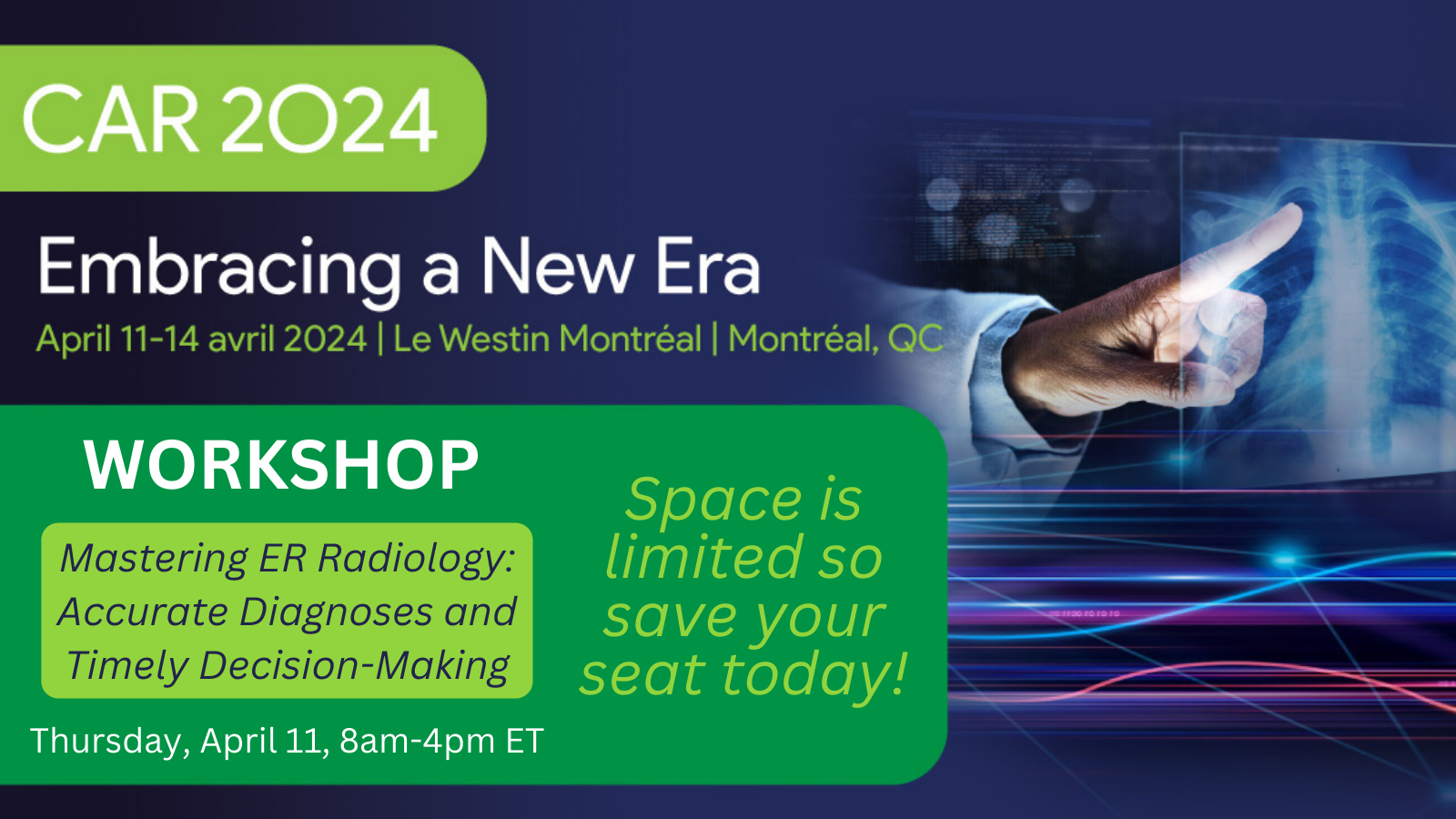A highlight of the CAR’s Annual Scientific Meeting is the educational workshop that provides an in-depth and hands-on approach to learning about specific topics in radiology. This year, CAR 2024 kicks off with a day-long workshop on emergency radiology called Mastering ER Radiology: Accurate Diagnoses and Timely Decision-Making. Experts from across the country will come together to put theory into practice in several areas of emergency radiology including abdominal, musculoskeletal, neuroradiology, and more.
Taking place on Thursday, April 11 from 8am-4pm ET, this workshop is designed for practicing radiologists and simulates real-case reporting. It is a fully accredited event and is eligible for a maximum of 19.5 Section 3 SIM MOC credits.
Dr. Viviane Khoury is President of the newest Affiliate Society, the Canadian Society of Skeletal Radiology (CSSR), and will present on musculoskeletal upper and lower extremity trauma through a variety of case-based examples and discussion points. She explains why emergency radiology is an important topic to cover at CAR 2024.
“Radiology plays a vital role in patient care in an emergency setting. A full-day workshop that is specifically focused on emergency radiology has the advantage of exploring in detail the unique aspects and challenges of this field.”
"Emergency radiology is a microcosm of the rapidly evolving changes in radiology," explained Canadian Society of Abdominal Radiology (CSAR) President Dr. Tanya Chawla, whose presentation will focus on abdominal imaging. "Not only is there an expectation for rapid turnaround times, but emergency radiology is where we encounter the trickiest cases. This is an area where subspecialty experts from the CAR's Affiliate Societies could share their experiences (and mistakes) with colleagues and enable them to see a collective of pathology in unparalleled depth. There will be learning for everyone irrespective of their level of training of experience."
The day consists of several high-impact didactic reviews in various subspecialties and multiple interpretation sessions where participants can review complete image files with the guidance and assistance of the expert faculty on hand. There will be an emphasis on common pathologies including important pitfalls and missed diagnoses.
The instructors, all of whom are fellowship-trained at academic centres, will offer their insights on how to interpret difficult imaging patterns and will provide tools for discerning normal and abnormal images. Practicing radiologists of all experience levels in reading images will be equipped with strategies for image acquisition, interpretation, and recognition of things commonly “missed”.
“This workshop will help attendees become expert diagnosticians in the timely and accurate interpretation of emergency room diagnostic images,” said Dr. Khoury. “Our aim as instructors is to boost attendees’ confidence in their current knowledge base and expand the broad skill set that this subspecialty requires.”
"Dr. Angus Hartery and I are gearing up for a fast-paced run through of a spectrum of non-traumatic abdominal and pelvic emergencies," explained Dr. Chawla. "We hope to show the bread-and-butter cases, but also reinforce learning of the rarer 'do-not-miss' pathologies. By using a case-based approach, there will be a very practical approach to learning."
Since it is an interactive workshop, Dr. Chawla advises participants to read the assigned cases ahead of time to get the full experience.
"Cases will be provided to participants in advance of the class, along with relevant reading if required, so there is an opportunity to get through a fairly large volume of cases during the day. Bring a positive attitude, a clear mind and a sense of humour!"

Key Learning Objectives
Recognize characteristic appearance of various causes of acute head to toe emergencies on plain radiography, CT, and US
Gain comprehensive knowledge in identifying and interpreting radiographic images of emergency cases, including a diverse range of head-to-toe emergencies, through hands-on simulations and case-based learning.
Develop a scientific approach to CT image acquisition of the emergency patient (in the trauma setting)
Acquire key strategies in CT image acquisition for emergency patients, particularly in trauma settings. Learn the intricacies of optimizing image quality while efficiently obtaining critical diagnostic information.
Facilitate an approach to the interpretation of the polytrauma patient in a trauma setting
Enhance your skills in interpreting radiographic findings in polytrauma patients within a trauma setting. Engage in interactive case studies to refine your approach and decision-making skills in managing complex emergencies.
Review common and uncommon fractures of the upper extremities, lower extremities, and pelvis with an emphasis on areas where findings are most often missed
Delve into the world of both common and uncommon fractures and gain insight on areas prone to oversight. Engage in practical exercises to reinforce your ability to detect fractures in the upper extremities, lower extremities, and pelvis.
Don't miss this chance to hone your emergency radiology skills! Seize the opportunity to learn from experts, engage in hands-on simulations, and connect with peers in a dynamic learning environment.
Space is limited and filling up fast, so be sure to register today and save your seat!

